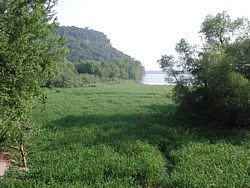
Effigy Mounds National Monument is located in the "Driftless (non-glaciated) Area" of northeastern Iowa. The Monument lies in a geologically unique area of erosional topography drained by an intricate system of rivers and streams. The erosional forces have cut through a plain leaving high divides and precipitous bluffs above adjacent waterways. The rugged landscape left by these forces supports a wealth of animal and plant species. The Mississippi and Yellow Rivers and adjacent wetlands are home to aquatic plants and animals, along with various species of fish, birds, amphibians, reptiles and small mammals. The eastern hardwood forests merge with the grasslands of the west. Early survey records reveal that northeastern Iowa was a heavily forested region interspersed with prairie openings. The prairie openings penetrated into the forest area along ridge tops with smaller prairie openings found on south facing bluff edges maintained by shallow soil, higher temperatures and drier conditions. The steep hillsides were dominated by successional climax stands of maple-basswood and oak-hickory vegetation communities. The prehistoric American Indians, whose burial and ceremonial sites are preserved at Effigy Mounds National Monument, found everything they needed to survive from the natural resources around them. Water, food, shelter, and medicine could all be found nearby. |
Last updated: January 3, 2016
